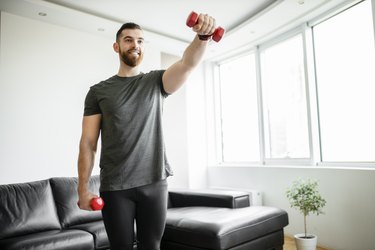
Sure, lifting heavy can help you grow bigger biceps, but did you know that a light dumbbell arm workout can help you achieve strong, sculpted arms, too?
The key is how you use them.
Video of the Day
When you lift light dumbbells — say, two or three pounds — you want to increase the number of reps you do per exercise. That's because by upping the reps, you more fully tax the muscle tissues, helping the fibers get stronger and build endurance over time.
Another way to make lifting lighter dumbbells work for you is to introduce pulsing, which means you're shortening the range of motion through small, repetitive movements. This makes the exercise more challenging because your muscles stay contracted throughout the entire exercise.
Doing a light dumbbell arm workout also decreases the risk of injury, so it's a great option for someone new to exercise or returning from a workout hiatus.
Ready to work those biceps, triceps and shoulders? Give this 20-minute light dumbbell arm workout a try. You'll have 45 seconds to complete each exercise. In that time, aim to do 15 to 20 reps. Take a 15-second break between exercises and repeat for a total of 5 rounds.
Tack this light dumbbell arm workout to the end of your strength-training session or in between a cardio workout for the ultimate burnout.
Check out more of our 20-minute workouts here — we’ve got something for everyone.
Move 1: Triceps Kickback
- Stand with your feet hip-width apart and hold a dumbbell in each hand.
- Hinge your hips back, creating a flat back. Your upper body should be just about parallel to the ground.
- Bring your arms to your sides and glue your elbows to your rib cage, forming a 90-degree angle with your arms.
- Without moving your shoulders, extend your arms back until they are straight, squeezing your triceps at the top.
- Return to the starting position.
Tip
Before hinging at the hips, slightly pinch your shoulder blades together. This will open up the chest to prevent your shoulders from rolling forward and help you achieve a flat back. Avoid swinging your arms and use slow and controlled movements to extend the weights behind you.
Move 2: Uppercut Pulse
- Stand with your feet hip-width apart and hold a dumbbell in each hand.
- Lift your arms up to form 90-degree angles so that your upper arms are parallel to the ground. Weights should be at about eye level.
- Pulse your arms up and down, bringing your hands just above and below your head.
Move 3: Lateral Raise to Front Raise
- Stand with your feet hip-width apart and hold a dumbbell in each hand.
- Lift your arms out to the side, stopping at shoulder height.
- Then, bring your arms together in front of your chest and lower them back down. This is 1 rep.
- Next, lift your arms back up in front of you to shoulder height, and open your arms back out to the sides.
- Lower them back down and repeat.
Move 4: Biceps Curl to Tap
- Stand with your feet hip-width apart and hold a dumbbell in each hand.
- Keep your elbows glued to your sides and turn your arms out to 45 degrees.
- Raise the dumbbells up to hip height.
- With your elbows still glued to your sides, bring the ends of the dumbbells together to touch.
- Bring the dumbbells back out, and then lower them back down to the starting position.
Move 5: Chest Opener to Shoulder Press
- Stand with your feet hip-width apart and hold a dumbbell in each hand.
- Hinge your hips back, creating a flat back. Your upper body should be just about parallel to the ground.
- Bend your arms to a 90-degree angle by your sides.
- Squeeze your shoulder blades together to lift your arms out to your sides. Think a football goalpost.
- Then, press your arms overhead.
- Pull your arms back to the goalpost position and then lower them back down to your sides.
Tip
Before hinging your hips, slightly pinch your shoulder blades together. This will open up your chest to prevent your shoulders from rolling forward so you can keep a flat back.